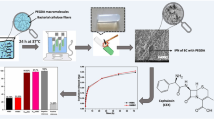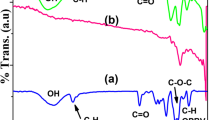Abstract
Highly water-soluble cyclosophoraose (Cys) has been recently used as a suitable complexation agent to enhance the solubility of drugs that are hardly water-soluble by molecular encapsulation via host–guest complexation. In this study, a novel Cys/cellulose hydrogel was prepared by cross-linking Cys and cellulose for efficient galangin delivery to improve antibacterial activity. Galangin was known to directly inhibit the activity of β-lactamase and to exhibit intrinsic antibacterial activity. The inhibition of β-lactamase by galangin was also known to enhance the eradication of a strain of methicillin-resistant Staphylococcus aureus. However, efficient delivery of galangin in an aqueous solution for improved antibacterial activity could not be achieved because of its extremely poor water solubility and bioavailbility. The structure and morphology of the resulting hydrogels were verified using with various instrumental techniques using rheometer, FT-IR spectroscopy, solid-state NMR spectroscopy, XRD and FE-SEM. The loading amount of galangin increased as the Cys content in the hydrogels increased, with a release time of 48 h. The galangin loading amount and its cumulative amount released from the Cys/cellulose hydrogel were 1.62- and 1.64-fold greater than those of galangin released from cellulose hydrogel, respectively. Additionally, the galangin-loaded Cys/cellulose hydrogel had antibacterial activity against S. aureus, with growth inhibition maintained up to 72 h. Furthermore, the Cys/cellulose hydrogel did not show any cytotoxicity toward human dermal fibroblasts. Throughout the study, the Cys/cellulose hydrogel demonstrated potential advantages as an efficient antibacterial dressing material for galangin delivery through targeting of drugs to the wound site in a sustained manner over a long period without frequent dressing changes.














Similar content being viewed by others
References
Abe M, Amemura A, Higashi S (1982) Studies on cyclic β-1,2-glucan obtained from periplasmic space of Rhizobium trifolii cells. Plant Soil 64:315–324. doi:10.1007/bf02372514
Chang C, Zhang L, Zhou J, Zhang L, Kennedy JF (2010) Structure and properties of hydrogels prepared from cellulose in NaOH/urea aqueous solutions. Carbohydr Polym 82:122–127. doi:10.1016/j.carbpol.2010.04.033
Cho E, Jung S (2015) Supramolecular complexation of carbohydrates for the bioavailability enhancement of poorly soluble drugs. Molecules 20:19620–19646
Cho E, Tahir MN, Kim H, Yu J-H, Jung S (2015) Removal of methyl violet dye by adsorption onto N-benzyltriazole derivatized dextran. RSC Adv 5:34327–34334
Choi Y-H, Yang C-H, Kim H-W, Jung S (2000) Molecular dynamics simulations of cyclohenicosakis-[(1 → 2)-β-d-gluco-henicosapyranosyl], a cyclic (1 → 2)-β-d-glucan (a ‘cyclosophoraose’) of DP 21. Carbohydr Res 326:227–234. doi:10.1016/S0008-6215(00)00050-1
Ciolacu D, Oprea AM, Anghel N, Cazacu G, Cazacu M (2012) New cellulose–lignin hydrogels and their application in controlled release of polyphenols. Mater Sci Eng, C 32:452–463. doi:10.1016/j.msec.2011.11.018
Constantin M, Bucatariu S, Harabagiu V, Ascenzi P, Fundueanu G (2014) Do cyclodextrins bound to dextran microspheres act as sustained delivery systems of drugs? Int J Pharm 469:1–9
Cushnie TT, Hamilton VE, Lamb AJ (2003) Assessment of the antibacterial activity of selected flavonoids and consideration of discrepancies between previous reports. Microbiol Res 158:281–289
Del Valle EMM (2004) Cyclodextrins and their uses: a review. Process Biochem 39:1033–1046. doi:10.1016/S0032-9592(03)00258-9
Dell A, York WS, McNeil M, Darvill AG, Albersheim P (1983) The cyclic structure of β-d-(1 → 2)-linked d-glucans secreted by Rhizobia and Agrobacteria. Carbohydr Res 117:185–200
Denizli BK, Can HK, Rzaev ZMO, Guner A (2004) Preparation conditions and swelling equilibria of dextran hydrogels prepared by some crosslinking agents. Polymer 45:6431–6435. doi:10.1016/j.polymer.2004.07.067
Denny BJ, Lambert PA, West PW (2002) The flavonoid galangin inhibits the L1 metallo-β-lactamase from Stenotrophomonas maltophilia. FEMS Microbiol Lett 208:21–24
Dong C, Qian L-Y, Zhao G-L, He B-H, Xiao H-N (2014) Preparation of antimicrobial cellulose fibers by grafting β-cyclodextrin and inclusion with antibiotics. Mater Lett 124:181–183. doi:10.1016/j.matlet.2014.03.091
Eumkeb G, Sakdarat S, Siriwong S (2010) Reversing β-lactam antibiotic resistance of Staphylococcus aureus with galangin from Alpinia officinarum Hance and synergism with ceftazidime. Phytomedicine 18:40–45
Fox SC, Li B, Xu D, Edgar KJ (2011) Regioselective esterification and etherification of cellulose: a review. Biomacromolecules 12:1956–1972
Gao Z, Zhao X (2004) Preparation and electrorheological characteristics of β-cyclodextrin–epichlorohydrin–starch polymer suspensions. J Appl Polym Sci 93:1681–1686
Geremia RA, Cavaignac S, Zorreguieta A, Toro N, Olivares J, Ugalde RA (1987) A Rhizobium meliloti mutant that forms ineffective pseudonodules in alfalfa produces exopolysaccharide but fails to form beta-(1–2) glucan. J Bacteriol 169:880–884
Hollman P, Katan M (1997) Absorption, metabolism and health effects of dietary flavonoids in man. Biomed Pharmacother 51:305–310
Isogai A, Usuda M, Kato T, Uryu T, Atalla RH (1989) Solid-state CP/MAS carbon-13 NMR study of cellulose polymorphs. Macromolecules 22:3168–3172
Jeon Y, Kwon C, Cho E, Jung S (2010) Carboxymethylated cyclosophoraose as a novel chiral additive for the stereoisomeric separation of some flavonoids by capillary electrophoresis. Carbohydr Res 345:2408–2412. doi:10.1016/j.carres.2010.08.009
Jeong D, Piao J, Kwon C, Jung S (2012) Synthesis of oligomeric microbial cyclosophoraoses as novel complexation agents. Bull Korean Chem Soc 33:2095–2098
Jullian C, Alfaro M, Zapata-Torres G, Olea-Azar C (2010) Inclusion complexes of cyclodextrins with galangin: a thermodynamic and reactivity study. J Solut Chem 39:1168–1177. doi:10.1007/s10953-010-9574-1
Katyal M, Singh R (1963) Spectrophotometric determination of zirconium and other colour reactions by galangin. In: Proceedings of the Indian Academy of Sciences-Section A, 1963, vol 4. Springer, pp 259–265
Kim MH, An S, Won K, Kim HJ, Lee SH (2012) Entrapment of enzymes into cellulose–biopolymer composite hydrogel beads using biocompatible ionic liquid. J Mol Catal B: Enzym 75:68–72. doi:10.1016/j.molcatb.2011.11.011
Kim H, Choi J, Choi Y, Tahir M, Yang Y-H, Cho E, Jung S (2014) Enhanced solubility of galangin based on the complexation with methylated microbial cyclosophoraoses. J Incl Phenom Macrocycl Chem 79:291–300. doi:10.1007/s10847-013-0351-9
Koizumi K, Okada Y, Horiyama S, Utamura T, Higashiura T, Ikeda M (1984) Preparation of cyclosophoraose-A and its complex-forming ability. J Incl Phenom 2:891–899. doi:10.1007/bf00662259
Kono H, Onishi K, Nakamura T (2013) Characterization and bisphenol A adsorption capacity of β-cyclodextrin–carboxymethylcellulose-based hydrogels. Carbohydr Polym 98:784–792. doi:10.1016/j.carbpol.2013.06ki.065
Kuo YN, Hong J (2005) Investigation of solubility of microcrystalline cellulose in aqueous NaOH. Polym Adv Technol 16:425–428
Lee S, D-h Seo, H-l Park, Choi Y, Jung S (2003) Solubility enhancement of a hydrophobic flavonoid, luteolin by the complexation with cyclosophoraoses isolated from Rhizobium meliloti. Antonie Van Leeuwenhoek 84:201–207
Li H, Yang J, Hu X, Liang J, Fan Y, Zhang X (2011) Superabsorbent polysaccharide hydrogels based on pullulan derivate as antibacterial release wound dressing. J Biomed Mater Res A 98:31–39
Lin N, Dufresne A (2013) Supramolecular hydrogels from in situ host–guest inclusion between chemically modified cellulose nanocrystals and cyclodextrin. Biomacromolecules 14:871–880
Lin W-C, Lien C-C, Yeh H-J, Yu C-M, S-h Hsu (2013) Bacterial cellulose and bacterial cellulose–chitosan membranes for wound dressing applications. Carbohydr Polym 94:603–611
Machín R, Isasi JR, Vélaz I (2012) β-Cyclodextrin hydrogels as potential drug delivery systems. Carbohydr Polym 87:2024–2030
Mathew AP, Oksman K, Sain M (2005) Mechanical properties of biodegradable composites from poly lactic acid (PLA) and microcrystalline cellulose (MCC). J Appl Polym Sci 97:2014–2025
Pan X-S, Hamlyn PJ, Talens-Visconti R, Alovero FL, Manzo RH, Fisher LM (2002) Small-colony mutants of Staphylococcus aureus allow selection of gyrase-mediated resistance to dual-target fluoroquinolones. Antimicrob Agents Chemother 46:2498–2506
Park H, Lee S, Kang S, Jung Y, Jung S (2004) Enantioseparation using sulfated cyclosophoraoses as a novel chiral additive in capillary electrophoresis. Electrophoresis 25:2671–2674. doi:10.1002/elps.200405971
Park S et al (2015) Application of cellulose/lignin hydrogel beads as novel supports for immobilizing lipase. J Mol Catal B: Enzym 119:33–39. doi:10.1016/j.molcatb.2015.05.014
Piao J et al (2014) Solubility enhancement of α-naphthoflavone by synthesized hydroxypropyl cyclic-(1 → 2)-β-d-glucans (cyclosophoroases). Carbohydr Polym 101:733–740
Pinho E, Henriques M, Soares G (2014) Cyclodextrin/cellulose hydrogel with gallic acid to prevent wound infection. Cellulose 21:4519–4530. doi:10.1007/s10570-014-0439-4
Siemoneit U, Schmitt C, Alvarez-Lorenzo C, Luzardo A, Otero-Espinar F, Concheiro A, Blanco-Méndez J (2006) Acrylic/cyclodextrin hydrogels with enhanced drug loading and sustained release capability. Int J Pharm 312:66–74. doi:10.1016/j.ijpharm.2005.12.046
Watanabe K, Nishio Y, Makiura R, Nakahira A, Kojima C (2013) Paclitaxel-loaded hydroxyapatite/collagen hybrid gels as drug delivery systems for metastatic cancer cells. Int J Pharm 446:81–86
York WS (1995) A conformational model for cyclic β-(1 → 2)-linked glucans based on NMR analysis of the β-glucans produced by Xanthomonas campestris. Carbohydr Res 278:205–225
Zhang L, Zhou J, Zhang L (2013) Structure and properties of β-cyclodextrin/cellulose hydrogels prepared in NaOH/urea aqueous solution. Carbohydr Polym 94:386–393. doi:10.1016/j.carbpol.2012.12.077
Acknowledgments
This paper was supported by Konkuk University in 2015. SDG.
Author information
Authors and Affiliations
Corresponding author
Electronic supplementary material
Below is the link to the electronic supplementary material.
Rights and permissions
About this article
Cite this article
Jeong, D., Kim, H., Jeong, Jp. et al. Cyclosophoraose/cellulose hydrogels as an efficient delivery system for galangin, a hydrophobic antibacterial drug. Cellulose 23, 2609–2625 (2016). https://doi.org/10.1007/s10570-016-0975-1
Received:
Accepted:
Published:
Issue Date:
DOI: https://doi.org/10.1007/s10570-016-0975-1




